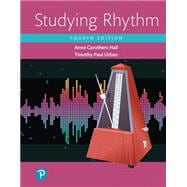
Studying Rhythm
by Hall, Anne Carothers, Professor Emeritus; Urban, Timothy P.-
 Complimentary 7-Day eTextbook Access - Read more
When you rent or buy this book, you will receive complimentary 7-day online access to the eTextbook version from your PC, Mac, tablet, or smartphone. Feature not included on Marketplace Items.
Complimentary 7-Day eTextbook Access - Read more
When you rent or buy this book, you will receive complimentary 7-day online access to the eTextbook version from your PC, Mac, tablet, or smartphone. Feature not included on Marketplace Items.
Buy New
Buy Used
Rent Textbook
Rent Digital
Downloadable: Lifetime Access
This item is being sold by an Individual Seller and will not ship from the Online Bookstore's warehouse. The Seller must confirm the order within two business days. If the Seller refuses to sell or fails to confirm within this time frame, then the order is cancelled.
Please be sure to read the Description offered by the Seller.
Summary
A thorough, practical introduction to rhythm
Studying Rhythm introduces students to the basic processes and complexities of musical rhythm and helps them develop the ability to perform all kinds of rhythmic patterns accurately at sight. Authors Anne Hall and Timothy Urban provide students over 300 one- and two-part rhythmic studies, each with short preliminary exercises, that are intended to be sung, spoken, and tapped or clapped. The Fourth Edition offers fresh examples from the standard repertory as well as new material on structured improvisation.
Author Biography
Although she had also taught piano and music history, she focused her teaching on music theory, especially theory of twentieth-century music, and on musical skills, the importance of which had been emphasized in her study in Paris. For the B.Mus. program at Laurier she developed four-year programs in music theory and musical skills. For the latter she composed the first version of Studying Rhythm in the early 1980s.
She served as Co-Chair of Minnesota Women in Higher Education, and later as the first chair of the Status of Women Committee of the Society for Music Theory, and then as the first chair of the Committee on Diversity of the SMT. She also served for six years on the Board of the Canadian University Music Society, including two years as President.
A major project, begun in 1980, was initiating and editing Jana Skarecky’s translation of Základy Modérni Harmonie by Karel Jane ek, Czech composer and theorist. This book, Foundations of Modern Harmony, is scheduled to be published in 2017 by the AMU Press in Prague.
Timothy Urban has been teaching undergraduate aural skills classes at the Mason Gross School of the Arts of Rutgers University for the past twenty years and gives regular clinics and workshops on aural skills pedagogy as well as advising teachers wishing to develop or enhance existing aural skills programs. He received his Ph.D. from Rutgers University after having been a Fulbright scholar at the Kodály Institute, Hungary. He holds graduate performance degrees in recorder and voice as well as an M.F.A in Early Music Performance Practice and continues to perform regularly as both singer and instrumentalist.
Table of Contents
2. Simple Triple Meter
3. Simple Quadruple Meter
4. Dotted Quarters and Tied Notes in Simple Meter
5. Compound Dupler Duple
6. Sixteenth-Notes in Simple Meter
7. Dotted Eighths in Simple Meter
8. Sixteenth-Notes in Six-Eight Meter
9. More Rests and Syncopation in Simple Meter
10. More Rests and Syncopation in Six-Eight Meter
11. Nine-Eight and Twelve-Eight Meter
12. Triplets
13. Two Against Three
14. Half-Note Beat (Simple Meter)
15. Dotted-Half-Note Beat (Compound Meter)
16. Eighth-Note Beat
17. Dotted-Eighth-Note Beat (Compound Meter)
18. Small Subdivisions
19. Changing Simple Meter
20. Changing Compound Meter
21. Changing between Simple and Compound Meter with the Division Constant
22. Changing between Simple and Compound Meter with the Beat Constant
23. Three Notes in Two Beats; Two Notes in Three Beats
24. Four Against Three
25. Four Notes in Three Beats; Three Notes in Four Beats
26. Quintuplets and Septuplets
27. Five-Eight and Five-Four Meter
28. More Meters with Unequal Beats
29. Changing Meters with Unequal Beats
30. More Cross Rhythms
31. Tempo Modulation
An electronic version of this book is available through VitalSource.
This book is viewable on PC, Mac, iPhone, iPad, iPod Touch, and most smartphones.
By purchasing, you will be able to view this book online, as well as download it, for the chosen number of days.
A downloadable version of this book is available through the eCampus Reader or compatible Adobe readers.
Applications are available on iOS, Android, PC, Mac, and Windows Mobile platforms.
Please view the compatibility matrix prior to purchase.
